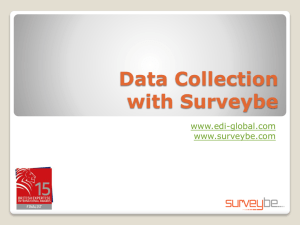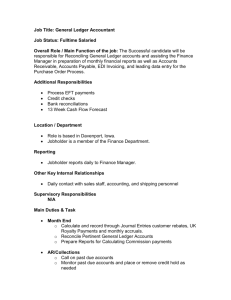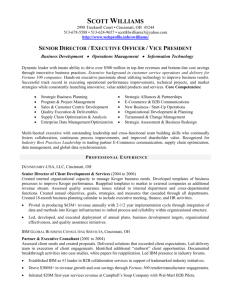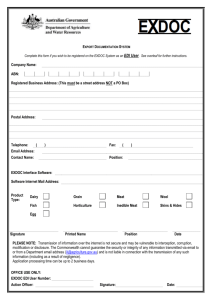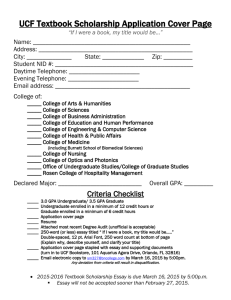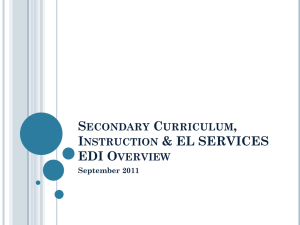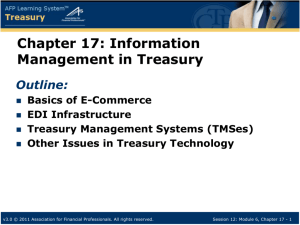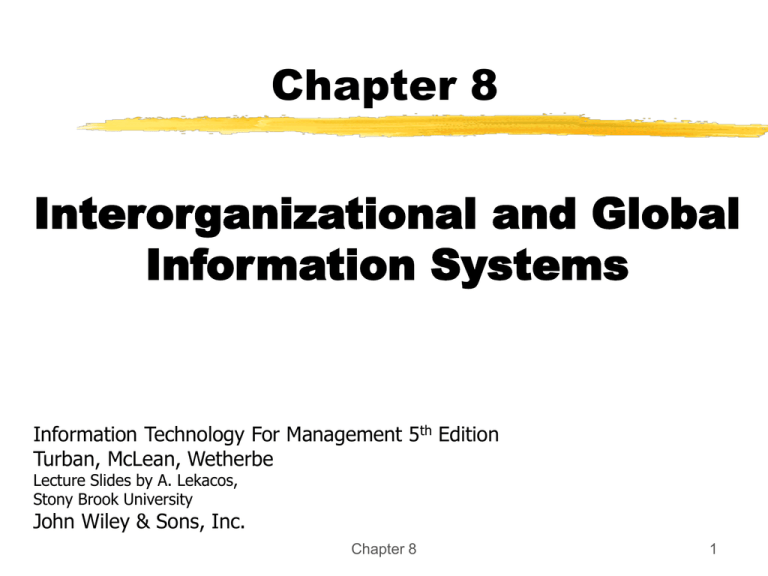
Chapter 8
Interorganizational and Global
Information Systems
Information Technology For Management 5th Edition
Turban, McLean, Wetherbe
Lecture Slides by A. Lekacos,
Stony Brook University
John Wiley & Sons, Inc.
Chapter 8
1
Learning Objectives
•
•
•
•
•
•
•
•
Define and classify IOSs.
Define and classify global information systems.
Present the major issues surrounding global information systems.
Describe B2B exchanges, hubs, and directories.
Describe virtual corporations and their IT support.
Describe EDI and EDI/Internet and their benefits and limitations.
Describe extranets, XML, and Web Services.
Present major IOS implementation issues.
Chapter 8
2
Interorganizational Information
System (IOS)
•
•
•
•
•
Interorganizational information system involves information
flow among two or more organizations.
Its major objective is efficient processing of transactions,
such as transmitting orders, bills, and payments.
It can be global or local.
When IOSs use telecommunications companies for
communication , they employ value-added networks (VANS).
These are private.
A growing trend is use of the Internet. These are publicly
accessible.
Chapter 8
3
Types of Interorganizational
Systems
● B2B trading systems. These systems are designed to facilitate trading between
(among) business partners. The partners can be in the same or in different
countries. B2B trading systems were covered in Chapter 4, where we
described both company-centric (private) e-marketplaces and many-to-many
public exchanges.
● B2B support systems. These are nontrading systems such as hubs, directories,
and other services.
● Global systems. Global information systems connect two or more companies
in two or more countries. The airline reservations system, SABRE, is an example
of a huge global system.
● Electronic funds transfer (EFT). In EFT, telecommunications networks
transfer
money among financial institutions.
● Groupware. Groupware technologies (Chapter 3) facilitate communication
and collaboration between and among organizations.
Chapter 8
4
Types of Interorganizational
Systems continued
● Integrated messaging. A single transmission system can be used to deliver
electronic mail and fax documents between organizations (see Chapter 3).
● Shared databases. Trading partners sometimes share databases in order to
reduce time in communicating information between parties and to arrange
cooperative activities (see Chapters 3, 4, and 8).
● Systems that support virtual corporations. These IOSs provide support to
virtual corporations—two or more business partners, in different locations,
sharing costs and resources to provide a product or service.
Chapter 8
5
ISO Support Technologies
The four major IOS technologies are:
•
•
•
•
•
Electronic Data Interchange (EDI), the electronic
movement of business documents between business partners.
Extranets, extended intranets that link business partners.
XML, an emerging B2B standard, promoted as a companion or
even a replacement for EDI systems.
WEB Services, the emerging technology for integrating B2B
and intrabusiness applications.
Chapter 8
6
Overview of IOSs
Chapter 8
7
Global Information Systems
Benefits
●Effective communication at a reasonable cost. The partners are far from each
other, yet they are able to work together, make decisions, monitor transactions,
and provide controls. Business partners communicate through e-mail,
EDI, Web Services (see the Dell opening case), and extranets. Communication
is even more critical if the partners speak different languages. Intelligent IT
systems can provide automatic translation.
● Effective collaboration to overcome differences in distance, time, language, and
culture. Collaboration can be enhanced with groupware software (Chapter 3),
group decision support systems (see Chapter 11), extranets, and teleconferencing
devices (Chapter 3).
● Access to databases of business partners and ability to work on the same
projects while their members are in different locations. Information technologies
such as video teleconferencing and screen sharing (Chapter 3) are
useful for this purpose.
Chapter 8
8
Issues in Global IS Design
● Cultural Differences. Culture consists of the objects, values, and other characteristics of a
particular society. It includes many different aspects ranging from tradition, to legal and ethical
issues, to what information is considered offensive. When companies plan to do business in countries
other than their own, they must consider the cultural environment.
● Localization. Many companies use different names, colors, sizes, and packaging for their
overseas products and services. This practice is referred to as localization. In order to maximize the
benefits of global information systems, the localization approach should also be used in the design
and operation of such systems.
● Economic And Political Differences. Countries also differ considerably in their economic
and political environments. One result of such variations is that the information infrastructures may
differ from country to country.
● Legal Issues. Legal systems differ considerably among countries. Examples are copyrights,
patents, computer crimes, file sharing, privacy, and data transfer.
Chapter 8
9
B2B Exchanges, Hubs, and
Directories
Chapter 8
10
B2B Exchanges, Hubs, and
Directories
Chapter 8
11
B2B Exchanges, Hubs, and
Directories
•
B2B Exchanges are used mainly to facilitate trading among
companies.
•
Hubs are used to facilitate communication and coordination
among business partners, frequently along the supply chain.
•
Directories appear as B2B Information portals, which usually
include catalogues of products offered by each seller, lists of
buyers, and what they want, and other industry or general
information.
Chapter 8
12
Computerized Supply
Chains
Chapter 8
13
Virtual Corporations and IT
Support
A virtual corporation (VC) is an organization composed of two or more
business partners, in different locations, sharing costs and resources
for the purpose of producing a product or service.
Most VCs cannot exist without information technology.
•
•
•
•
•
E-mail
Desktop videoconferencing
Screen sharing and other groupware technologies
EDI and EFT
Database and network sharing
Chapter 8
14
Electronic Data Interchange
(EDI)
•
EDI is a communication standard that enables the electronic
transfer of routine documents, such as purchasing orders,
between business partners.
•
Traditional EDI has been around for about 30 years.
•
EDI reduces costs, delays, and errors inherent in a manual
document – delivery system.
Chapter 8
15
Electronic Data Interchange
(EDI) continued
● EDI translators. An EDI translator converts data into a standard format
before it is transmitted; then the standard form is converted to the original data.
● Business transactions messages. These include purchase orders, invoices,
credit approvals, shipping notices, confirmations, and so on.
● Data formatting standards. Because EDI messages are repetitive, it makes
sense to use formatting (coding) standards. In the United States and Canada,
EDI data are formatted according to the ANSI X.12 standard. An international
standard developed by the United Nations is called EDIFACT.
Chapter 8
16
Electronic Data Interchange
(EDI) continued
Chapter 8
17
Electronic Data Interchange
(EDI) continued
Chapter 8
18
Electronic Data Interchange
(EDI) continued
● Accessibility. The Internet is a publicly accessible network with few geographical
constraints. Its largest attribute, large-scale connectivity (without the need for any special
company networking architecture), is a seedbed for growth of a vast range of business
applications.
● Reach. The Internet’s global network connections offer the potential to reach the widest
possible number of trading partners of any viable alternative currently available.
● Cost. The Internet’s communication cost can be 40 to 70 percent lower than that of
VANs. Transmission of sensitive data can be made secure with VPN.
● Use of Web technology. Using the Internet to exchange EDI transactions is consistent
with the growing interest of business in delivering an ever increasing variety of products
and services via the Web. Internet-based EDI can complement or replace many current
EDI applications.
● Ease of use. Internet tools such as browsers and search engines are very user friendly,
and most employees today know how to use them.
● Added functionalities. Internet-based EDI has several functionalities not provided by
traditional EDI, which include collaboration, workflow, and search engine capabilities (see
Boucher-Ferguson, 2002).
Chapter 8
19
Electronic Data Interchange
(EDI) continued
Chapter 8
20
Extranets, XML, and WEB Services
Extranets are networks that link business partners to one
another over the Internet by providing access to certain areas of
each other’s corporate intranets.
Chapter 8
21
Extranets, XML, and WEB Services
Three major types of Extranets
•A Company and its Dealers, Customers, or Suppliers. An
example is FEDEX Extranet that allows customers to track the status of a
package.
•An Industry’s Extranet. The world’s largest industry based ,
collaborative extranet is by General Motors, Ford, and DaimlerChrysler.
That Extranet ,called Automobile Network Exchange (ANX), links the
carmakers to 10,000 suppliers.
•Joint Ventures and Other Business Partnerships. An example
is Bank Of America’s Extranet for commercial loans.
Chapter 8
22
Extranets, XML, and WEB Services
XML (eXtensible Markup Language) is a simplified version
of a general data description language known as SGML.
• XML describes data and information.
• XML does not say how the data will be displayed.
• XML can be used to send complex messages that include different files.
• XML and HTML are not the same.
• XML is a flexible language.
• XML is easily read and understood.
• XML requires less specialized skills.
Chapter 8
23
Extranets, XML, and WEB Services
WEB Services are universal, prefabricated business process
software modules, delivered over the Internet, that users
can select and combine through almost any device,
enabling disparate systems to share data and services.
•Web services can support IOSs by providing easy integration for
different internal and external systems.
•Such integration enables companies to develop new applications .An
example is Allstate Financial Group used Microsoft.NET (a Web Services
implementation) to create AccessAllstate.com, a Web Portal that allows its
350,000 sales representatives to access information about Allstate
investment, retirement, and insurance products.
Chapter 8
24
Partner Relationship Management
Every company that has business partners has to manage the
relationships with them. Information needs to flow between the firms
and constantly updated and shared.
• Manual methods include; phone, fax, and mail
• EDI is typically used by large corporations
• EC PRM functions include:
•partner profiles
•partner communications
•lead management (of clients)
•targeted information distribution
•connecting the extended enterprise
•partner planning
•centralized forecasting
•group planning
•e-mail
•price lists
Chapter 8
25
Partner Relationship Management
Continued
Chapter 8
26
Supplier Relationship Management
One of the major categories of PRM is SRM, where the partners
are the suppliers.
• PeopleSoft’s SRM model is an example.
• It is a model for managing relationships with suppliers in real time.
• It includes 12 steps using the core idea that an e-supply chain is
based on integration and collaboration.
Chapter 8
27
MANAGERIAL ISSUES
•
Selecting a system. Companies have an option to select an IOS infrastructure from
•
Partners’ collaboration. An IOS has at least two participating organizations, so
•
New infrastructures. XML, Web Services, and other tools are gaining converts but
several types and vendors.
collaboration is critical. Many failures of EDI adoption, for example, result from lack of
partners’ cooperation. If you are Wal-Mart, you may be able to mandate that your partner
cooperate (or be excluded from doing business with you). But most other companies
need to persuade partners, showing them mutual benefits, or provide them with
incentives.
are not universally accepted. Companies like Dell can lead in using such new
infrastructures, but smaller companies might be better off to wait and see. However,
management must assess the risk of waiting while competitors are moving.
Chapter 8
28
MANAGERIAL ISSUES
•
Globalization. The issue of going global or not, or to what extent, depends on what
•
Using exchanges, hubs, and other services. These are viable options since
•
Partner and supplier relationship management. Modern business is
information systems are needed for supporting the globalization. Issues such as multiple
languages, different currencies, tax requirements, legal aspects, and cultural
considerations need to be reflected in the supporting IT (e.g., see Minicase 2).
Globalization may not be simple or inexpensive.
the service providers provide the IOS infrastructure. Also, frequently the Internet can be
used. Using third-party providers can be cheaper, but you may lose some control over the
system. Again, selecting the appropriate system(s) is critical.
increasingly using partners, as we have seen in several examples throughout the book.
The trend for outsourcing, for example, means more partners.
Chapter 8
29
Chapter 8
Copyright © 2005 John Wiley & Sons, Inc. All rights
reserved. Reproduction or translation of this work
beyond that permitted in Section 117 of the 1976
United States Copyright Act without the express
written permission of the copyright owner is
unlawful. Request for further information should be
addressed to the Permissions Department, John
Wiley & Sons, Inc. The purchaser may make backup copies for his/her own use only and not for
distribution or resale. The Publisher assumes no
responsibility for errors, omissions, or damages,
caused by the use of these programs or from the
use of the information contained herein.
Chapter 8
30


